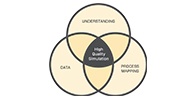What do you need for a high-quality simulation model?

In my previous post, “What can simulation do for your health system?” I highlighted some of the merits of performing discrete event simulations. This second installment brings to light what I believe are the main components necessary to develop a high-quality simulation.
A working simulation model comprises three important elements: data, process maps and understanding. Data and process maps can be gathered by hand or from computer programs. Understanding depends on the relationship between the model developer and the client, making it more subjective than the other two.

Understanding the health system and the question(s) the model addresses is imperative for a high-quality simulation model. Each model is unique and depends on the question(s) being asked. For example, a surgery center looking to expand may ask how many recovery rooms they need to accommodate 20 patients each day. Based on that question and their understanding of the system, the modeler makes assumptions about which elements are essential for the simulation to produce valuable results and works with the client to ensure all critical steps of the process are included in the model. The modeler should ask to observe at the facility and speak with some of the front-line employees to grasp the current state better. These interactions lead to a higher level of understanding, resulting in a well-defined simulation model.
A process map of the desired system should be developed at the time of observation. The process map, a “floor plan” for the simulation model, shows entities where they need to go in the system. A high-quality simulation shows only the necessary process steps with no added complexity.
Data is the driver behind the map. Without data, the simulation cannot represent the system accurately. There are various methods of gathering data for a model, including time studies and databases. No matter the method, the amount and quality of the data is most important. A simulation is only as good as the data driving it.
Large sets of good data, a properly detailed process map and a considerable understanding of the system are essential to create a high-quality model. An excellent modeler will thoroughly research each step, ensuring it fits well into the scope of the question being asked.
Click the button below to read an in-depth example of how Array used simulation for design validation.

